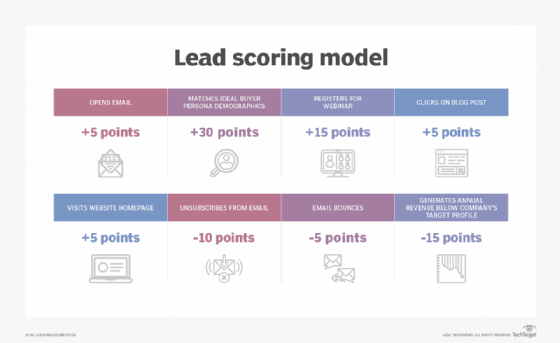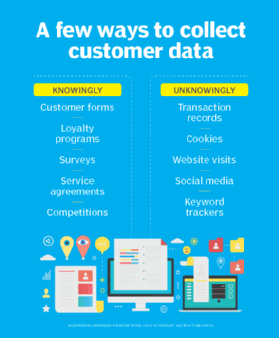lead scoring
Lead scoring is a methodology used by sales and marketing departments to determine the worthiness of leads, or potential customers, by attaching values to them based on their behavior relating to their interest in products or services.
The "value" of each lead varies from company to company, but generally is characterized by the interest shown in the company or their places in the buying cycle. Companies assign point-based systems in qualifying leads or simply refer to them as "hot," "warm" or "cold" based on the history of interactions.
The first goal of companies is to get sales leads or prospects into their pipeline. Once a substantial number of leads have been obtained, it's important for companies to focus on the prospects that are most interested in buying, which is where lead scoring can play an important role.
The lead scoring process
Sales and marketing teams must agree on the definition of a qualified lead for the lead scoring process to begin. To score a lead, information is gathered about the lead's occupation and role in that industry to determine whether they're appropriate to sell to. Information about a lead's activities, demographics or areas of interest also come into play when figuring out whether that lead would be interested in a company's products or services.
Each action is assigned a point value depending on how likely the software predicts that action will lead to a purchase. Leads who are an ideal fit and who have expressed a high interest in a company are deemed marketing-qualified leads and are typically passed to sales departments, whereas those who are deemed a good fit but with minimal interaction are sent to marketing teams for lead nurturing.
To help measure a lead's level of interest in a product or service, organizations can track the following:
- Which email messages leads respond to.
- Which pages they visit on the company website.
- How long they look at the pages.
- If they filled out or downloaded any forms.
- Whether they clicked on a blog post or engaged on social media.
The importance of various metrics can change depending on whether the company is selling a product or service and what industry they are selling to.

The importance of lead scoring data
Companies use historical data from processes such as marketing automation to predict a typical path that a customer takes before a sale is made. Using practices such as inbound marketing, marketing automation, customer data and lead nurturing, companies can examine which pieces of content are most engaging to customers and how many interactions between the company and prospect it took to turn that person into a customer.
It's partly this lead scoring process that allows sales teams to separate a customer's interest in products from their intent to buy. For instance, website page views or downloads of certain documents may indicate that a prospect is merely interested but not intending to buy anything. These actions will be scored lower than customers who send buying signals by requesting a trial or viewing a pricing page. Determining the value of actions typically requires input from marketing and sales teams.
If companies invest in lead scoring software to improve their overall sales process, it's important that marketing and sales teams closely align their lead management efforts. The technology must also be properly set up with the right metrics and should be used consistently. Otherwise, the lead scoring data may paint an incomplete picture of potential prospects, and lead sales and marketing reps down a disadvantageous path.
Lead scoring metrics
Companies use various metrics to determine the success of lead scoring efforts. Sales teams should understand these metrics, which can vary from company to company, so they can optimize the effectiveness of their lead scoring systems.

Unsubscribe rates on emails. These rates measure the effectiveness of marketing campaigns and diagnose inaccurate targeting methods or flaws in the content. Conversely, response rates, or "clickthrough" rates -- the rate at which prospects open certain marketing materials or otherwise perform an intended action -- can measure the quality and effectiveness of the produced content.
Lead engagement rate. Sales teams can compare lead scores -- or engagement scores -- of nurtured leads against those that haven't been touched by any sort of sales or marketing materials. This comparison lets them calculate the lead engagement rate.
A drop in this metric signifies a need to update content or explore new channels of engagement. If companies focus content on guiding prospects to engage with the organization in a certain way, the lead engagement rate can show how effective certain types of content are.
The source of information. Information sources that prospects use can indicate how interested they are in becoming a customer. For example, if they find content on a third-party site and click on it or download it, the prospect may be just gathering information on the software market. If the prospect exhibits buying signals by following or interacting with social media accounts, requesting trials or demos or visiting pricing pages, they may gain a higher lead score.
Sales cycle time. The sales cycle is the length of time it takes for a lead to become a customer. A shorter sales cycle indicates a more effective lead nurturing and scoring process.
Upsell and cross-sell rates. Organizations can track how often sales teams successfully upsell and cross-sell products to leads. Lead scoring systems should value highly engaged leads that are well-versed on products because these leads are more likely to buy upgrades and additional products. A low upsell and cross-sell rate can indicate that an organization needs to adjust its lead scoring system to more strongly prioritize this type of customer.
Lead scoring tools
There are many software tools that can help companies implement lead scoring. Most large CRM vendors have some form of lead scoring tools, including Salesforce Einstein Lead Scoring, Microsoft Dynamics 365 Marketing, Adobe Campaign, Oracle Marketing and SAP Sales Cloud.
Beyond the large CRM vendors, many independent software companies also offer third-party lead scoring tools to plug into marketing and sales tools. This includes companies like Dun & Bradstreet, 6sense, Zoominfo, Marketo, Televerde, Leadspace and many more.
Lead scoring tools help companies capture leads and nurture them by monitoring their activity and then scoring it. Lead scoring software offers little value on its own, but when plugged into CRM systems and pipeline workflows, it can provide tremendous value by putting sales reps and marketers in front of the right prospect at the right time.
To help marketing and sales teams, lead scoring tools must do the following:
- Create and manage ranking scales for leads. Organizations should base these scales on their organization's goals and market position. For companies that focus on enterprise customers, nurturing small and medium-sized customers as leads would be detrimental.
- Let users assign scores to leads. These tools should let sales agents score leads with their organization's predefined ranking system. If a company targets enterprises, its lead scoring system should score enterprise prospects higher than small businesses.
- Offer reporting and analytics features. These features can ensure leads align with what the company seeks in a customer.
- Integrate with external systems. Lead scoring tools should offer integrations with sales and marketing software, as well as analytics and artificial intelligence platforms.
- Provide importing and exporting capabilities. These systems should let companies import data from other sources, such as surveys or industry statistics. Lead scoring results must be easy to export for use in reporting tools.
Editor's note: This article was written by Jesse Scardina in 2018. TechTarget editors revised it to improve the reader experience.






